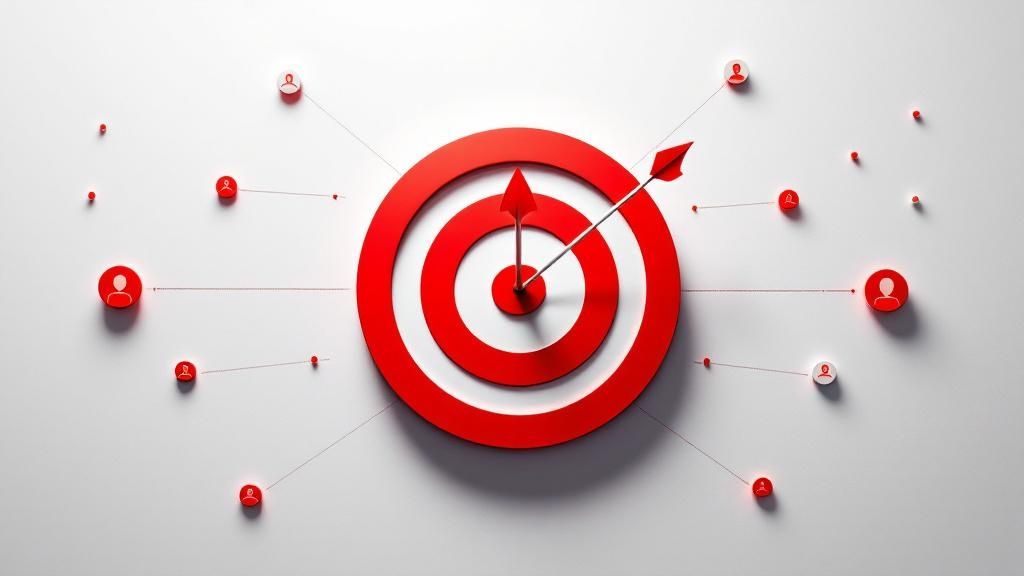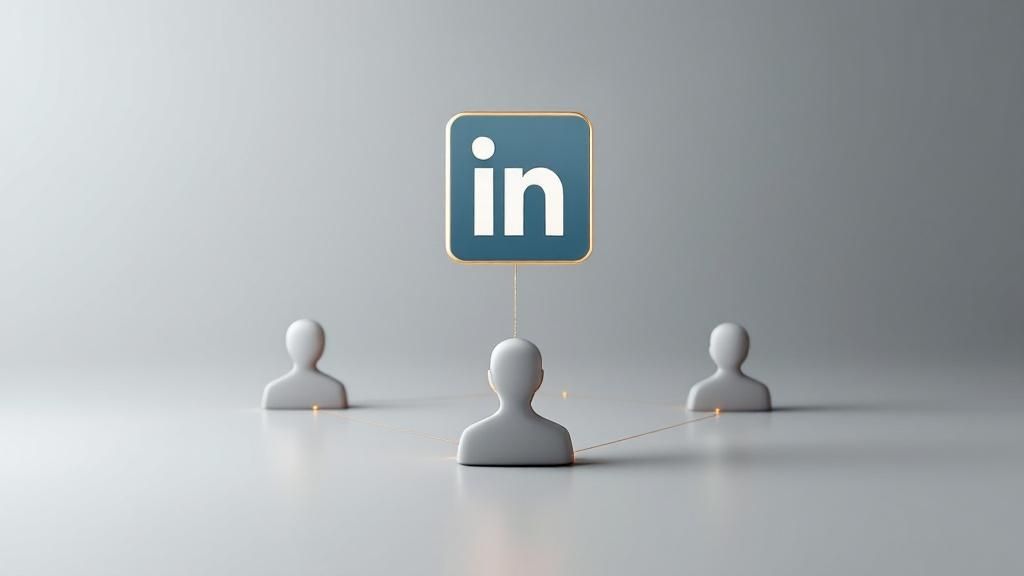In the competitive B2B landscape, a steady stream of high-quality leads isn't a luxury; it's the engine of survival and growth. But with countless channels and tactics available, identifying the most effective b2b lead generation strategies can feel overwhelming. Many businesses fall into the trap of chasing trends or implementing tactics without a cohesive plan, leading to wasted resources and a stagnant pipeline.
This guide cuts through the noise. We are moving beyond generic advice to provide a detailed blueprint for 10 proven strategies that deliver tangible results. Each section is broken down with actionable steps, real-world examples, and the specific metrics you need to track your success. For a deeper dive into crafting a comprehensive blueprint for B2B growth and lead generation, explore these Top B2B Lead Generation Strategies for 2025.
Whether you're a solo professional, part of a small-to-medium sized sales team, or an enterprise organization, this in-depth roundup will equip you with the knowledge to build a robust, predictable, and scalable lead generation machine. You will learn to execute sophisticated tactics ranging from hyper-targeted Account-Based Marketing (ABM) and leveraging LinkedIn Sales Navigator to building unshakeable thought leadership through content and SEO. This isn't a list of ideas; it's a practical manual for turning outreach into opportunity and prospects into long-term partners.
1. Content Marketing & Thought Leadership: Build Authority That Attracts
Content marketing is a long-game approach focused on creating and distributing valuable, relevant, and consistent content to attract and retain a specific audience. This core B2B lead generation strategy shifts the focus from direct sales pitches to building trust and authority. By consistently solving your audience's problems, your brand becomes the go-to resource in your industry, organically generating high-quality inbound leads who already see you as a credible partner.

This method, championed by industry pioneers like HubSpot and the Content Marketing Institute, works by addressing customer pain points before they ever see a product demo. Consider how Salesforce’s Trailhead platform educates users, building deep brand loyalty, or how Mailchimp’s marketing guides attract small businesses actively seeking solutions. The goal is to establish your brand as an indispensable thought leader.
How to Implement This Strategy
- Identify Buyer Personas: Create detailed profiles of your ideal customers, including their challenges, goals, and information sources. Tailor all content to address these specific needs.
- Focus on Originality: Use internal data, customer surveys, or industry partnerships to create original research and reports. This unique content establishes authority and attracts valuable backlinks, boosting SEO.
- Optimize and Repurpose: Optimize every piece of content for search engines using relevant keywords. Maximize reach by repurposing a single asset, like a webinar, into blog posts, social media snippets, and infographics. Effective content distribution is key, especially on professional networks. Find out more with this definitive guide to B2B content distribution on LinkedIn.
- Embed Clear CTAs: Every blog post, whitepaper, or video should guide the audience to the next logical step, whether it's subscribing to a newsletter, downloading a resource, or booking a demo.
2. Account-Based Marketing (ABM): Hyper-Targeting for High-Value Wins
Account-Based Marketing (ABM) flips the traditional marketing funnel on its head. Instead of casting a wide net to capture as many leads as possible, ABM is a highly focused B2B lead generation strategy where marketing and sales teams collaborate to target a specific set of high-value accounts. This approach treats individual accounts as unique markets, delivering personalized experiences designed to engage key decision-makers and drive revenue from your most desired clients.

This method was pioneered by organizations like ITSMA and championed by leaders such as Jon Miller of Demandbase and Sangram Vajre of Terminus. It's incredibly effective because it eliminates wasted resources on low-potential prospects. For example, Snowflake executes hyper-targeted campaigns for Fortune 500 companies, while Demandbase uses its own platform to deliver personalized website experiences to its target accounts. The core principle is simple: focus your energy where it will yield the greatest return.
How to Implement This Strategy
- Define Your Ideal Customer Profile (ICP) and Target Account List (TAL): Start by identifying the firmographic and technographic characteristics of your best customers. Use this ICP to build a curated list of high-value target accounts that fit this mold perfectly.
- Align Sales and Marketing: True ABM success requires a tight partnership between sales and marketing. Both teams must agree on the target accounts, develop cohesive messaging, and coordinate outreach efforts across multiple channels. This alignment ensures a seamless and consistent experience for the target account.
- Create Account-Specific Content: Generic content won't work. Develop personalized assets that speak directly to the specific challenges, goals, and industry of each target account. This could include account-specific case studies, personalized landing pages, or bespoke industry reports.
- Execute a Multi-Channel, Multi-Touch Campaign: Engage decision-makers across various channels, including targeted ads, personalized email sequences, direct mail, and social media outreach. The goal is to surround the account with your value proposition, building awareness and engagement over time. To better integrate your sales efforts with this approach, you can learn more about how to implement account-based sales for your B2B team.
3. LinkedIn Sales Navigator & Social Selling
Social selling on LinkedIn moves beyond random connection requests to a systematic approach for building authentic relationships with potential buyers. This strategy leverages LinkedIn's professional network, especially with the powerhouse tool Sales Navigator, to identify, connect with, and nurture prospects. Instead of cold pitching, you establish credibility by sharing valuable content and engaging in meaningful conversations, positioning yourself as a trusted advisor.

This methodology, championed by experts like Jill Konrath and the LinkedIn Sales Solutions team, transforms the platform into a dynamic lead generation engine. Consider how Oracle’s sales teams use Sales Navigator for targeted enterprise outreach or how Microsoft’s own sellers leverage it to deepen relationships within key accounts. The essence is to build rapport and provide value long before a sales conversation begins, making it a cornerstone of modern B2B lead generation strategies.
How to Implement This Strategy
- Optimize Your Profile: Your LinkedIn profile is your digital storefront. Optimize it with a professional headshot, a benefit-driven headline, and a summary that speaks directly to your ideal customer's pain points. A strong profile is crucial for establishing credibility.
- Target with Precision: Use Sales Navigator’s advanced search filters, including Boolean operators, to create highly specific lead lists. You can target prospects by industry, company size, seniority level, and even recent job changes or content engagement.
- Engage Before Connecting: Don't just send a connection request. Follow your prospects, engage with their posts by leaving thoughtful comments, and share content relevant to their industry. This warms up the interaction and increases acceptance rates.
- Personalize Your Outreach: When you do connect, ditch the generic template. Reference a shared connection, a recent post they made, or a company announcement. A personalized message shows you’ve done your homework and are genuinely interested in them, not just their business.
4. Email Marketing & Automation: Nurture Leads at Scale
Email marketing remains one of the most effective and direct B2B lead generation strategies, delivering a consistently high ROI. This approach involves a systematic method of nurturing leads through targeted email campaigns and automated sequences. By segmenting prospects based on behavior, demographics, and engagement levels, you can deliver personalized content that guides them through the buyer's journey, from initial awareness to decision-making.

This strategy is about delivering the right message to the right person at the right time, a principle championed by experts like Ann Handley and Kath Pay. For example, HubSpot's sophisticated lead nurturing workflows automatically send relevant content based on a contact's interactions with a website. Similarly, Mailchimp’s welcome series for new subscribers effectively onboards users and builds an immediate connection. This level of automation allows you to nurture relationships and scale your outreach without sacrificing personalization.
How to Implement This Strategy
- Segment Your Lists: Group contacts based on buyer personas, industry, company size, or behavioral triggers like downloading a specific resource. This ensures your messaging is always highly relevant.
- Craft Compelling Copy: Your subject line and preview text are your first impression. Make them irresistible to boost open rates. The email body should be concise, focused, and provide clear value to the reader.
- Include a Single, Clear CTA: Each email should have one primary goal. Whether it's to "Download the Report," "Watch the Webinar," or "Book a Demo," a single, clear call-to-action eliminates confusion and improves conversion rates.
- Test and Optimize: A/B test different elements like subject lines, send times, and content formats to understand what resonates most with your audience. Continuously monitor deliverability and clean your lists to remove inactive subscribers.
5. Search Engine Optimization (SEO)
Search Engine Optimization (SEO) is a fundamental, long-term B2B lead generation strategy focused on increasing your website's visibility in organic search engine results. By optimizing your site’s content, technical foundation, and authority, you can attract high-intent buyers actively searching for solutions like yours. When a decision-maker types a problem into Google, SEO ensures your business appears as the most credible and relevant answer.
This strategic discipline, pioneered by experts like Rand Fishkin and Brian Dean, transforms your website into a passive lead generation machine. Consider how Ahrefs dominates search results for thousands of SEO-related keywords, attracting a constant stream of qualified users. Similarly, Zapier’s "best apps for X" and integration pages capture traffic from professionals looking to connect their software, turning search queries directly into product-aware leads.
How to Implement This Strategy
- Target Commercial Intent Keywords: Focus on long-tail keywords that signal a user is close to making a purchase decision, such as "best CRM for small law firms" or "manufacturing ERP software comparison." These queries attract users with higher buying intent.
- Create Comprehensive Pillar Content: Develop in-depth articles, guides, and resource hubs that thoroughly answer a user's question. Content that serves as a one-stop-shop for a topic tends to rank higher and attract more authoritative backlinks.
- Optimize for Featured Snippets: Structure your content to directly answer common questions with concise paragraphs, lists, or tables. Securing the "position zero" featured snippet dramatically increases visibility and click-through rates.
- Prioritize Technical Health and User Experience: Ensure your website loads quickly, is mobile-friendly, and provides a seamless user experience. Search engines reward sites that are easy for both users and crawlers to navigate. For comprehensive insights into this critical lead generation channel, explore more about search engine optimization here.
6. Webinars & Virtual Events: Engage and Educate at Scale
Webinars and virtual events are powerful, interactive B2B lead generation strategies that allow you to engage a captive audience in real-time. Instead of a static piece of content, these live or pre-recorded sessions create a direct channel to educate prospects, demonstrate expertise, and build personal connections. By offering significant value and addressing specific industry challenges, you can attract a highly qualified audience actively seeking solutions, making the lead generation process both efficient and effective.
This strategy has been popularized by platforms like Zoom and GoToWebinar and perfected by marketing experts like Amy Porterfield and Russell Brunson. It works by creating an event-based incentive for prospects to share their contact information. Consider how Salesforce uses its Trailhead Live events to provide ongoing education and product insights, or how Gartner’s webinars disseminate exclusive industry research to attract high-level decision-makers. The goal is to create a valuable, can't-miss experience that positions your brand as a helpful expert and your solution as the logical next step.
How to Implement This Strategy
- Choose a High-Value Topic: Select a topic that directly addresses a pressing pain point for your ideal buyer persona. Use keyword research and customer feedback to find subjects that are in high demand, ensuring strong registration numbers.
- Promote Extensively: Begin promoting your webinar at least two to three weeks in advance across multiple channels, including email marketing, social media (especially LinkedIn), and partner networks. Use a dedicated landing page that clearly outlines the value proposition and what attendees will learn.
- Engineer Engagement: Don't just present; interact. Incorporate live polls, Q&A sessions, and chat features to keep the audience engaged. This two-way communication provides invaluable insights into your audience's needs and challenges.
- Develop a Follow-Up Cadence: The work isn't over when the webinar ends. Create a segmented follow-up strategy for attendees and no-shows. Send the recording and slides to everyone, but tailor subsequent emails based on engagement, such as offering a demo to those who asked questions or stayed for the entire event.
7. Pay-Per-Click (PPC) Advertising: Capture High-Intent Demand
Pay-Per-Click (PPC) advertising is a powerful strategy for driving immediate, targeted traffic to your website by placing ads on platforms like Google and LinkedIn. Unlike organic methods that take time to build momentum, this approach allows you to bid on specific keywords and place your solution directly in front of prospects who are actively searching for what you offer. It's one of the most direct and measurable B2B lead generation strategies available.
This method, championed by digital marketing experts like Perry Marshall and Brad Geddes, allows businesses to generate leads with high purchase intent. Consider how Slack runs Google Ads for terms like "team communication software," capturing users at the exact moment of need. Similarly, Microsoft leverages highly targeted LinkedIn ads to promote its B2B software solutions to specific job titles and industries, ensuring maximum relevance and a higher likelihood of conversion.
How to Implement This Strategy
- Create Tightly Themed Ad Groups: Don't lump all your keywords into one ad group. Instead, organize them into small, highly specific groups that correspond directly with your ad copy and landing page. This improves your Quality Score and lowers your cost-per-click.
- Utilize Negative Keywords: Actively build a list of negative keywords to prevent your ads from showing for irrelevant searches. For example, a B2B software company might add "free," "jobs," or "template" to its negative keyword list to filter out non-commercial traffic and protect its budget.
- Design Dedicated Landing Pages: Never send PPC traffic to your homepage. Create dedicated, conversion-focused landing pages for each campaign with a single, clear call-to-action. The message on the landing page must align perfectly with the ad copy that the user clicked.
- Implement Robust Conversion Tracking: Meticulously track every conversion, from a form submission to a phone call. This data is essential for calculating your return on investment (ROI) and optimizing campaigns by reallocating your budget to the ads and keywords that are actually generating valuable leads.
8. Referral & Partnership Programs: Scale Through Your Network
Referral and partnership programs are structured systems designed to leverage your existing network of customers, partners, and industry peers to generate new leads. Rather than waiting for word-of-mouth to happen organically, this strategy formalizes the process with clear incentives, turning satisfied clients and strategic allies into a proactive, high-quality lead generation engine. These leads often come with a high level of trust and a shorter sales cycle because they are recommended by a source the prospect already knows and respects.
This approach was famously turbocharged by Dropbox, whose simple two-way referral program drove exponential user growth. In the B2B world, companies like HubSpot have built a powerful ecosystem by rewarding agency partners for bringing in new customers. These B2B lead generation strategies work because they are built on the most powerful marketing tool: a trusted recommendation. By creating mutual value, you build a loyal network that actively contributes to your pipeline.
How to Implement This Strategy
- Design a Simple, Rewarding System: Create a referral process that is incredibly easy for your customers to use. Offer compelling incentives that are valuable to both the referrer and the new lead, such as service credits, gift cards, or exclusive features.
- Equip Your Partners for Success: For strategic partnerships, provide co-branded marketing materials, sales enablement resources, and dedicated support. Make it easy for them to represent your brand effectively and integrate your solution into their offerings. Platforms like PartnerStack can help manage this process.
- Track and Attribute Meticulously: Implement robust tracking to ensure every referral is properly attributed. This data is crucial for measuring ROI, identifying your top-performing advocates, and optimizing your program for better results.
- Communicate and Celebrate: Maintain regular communication with your referrers and partners. Keep them updated on their referral status and publicly celebrate top performers to foster a sense of community and friendly competition.
9. Cold Outreach & Sales Development: Proactively Filling the Pipeline
Cold outreach is a proactive outbound strategy focused on initiating conversations with potential customers who have not previously expressed interest in your brand. It involves a systematic process of identifying, researching, and contacting prospects through personalized emails, calls, or social media messages. Far from being spam, modern sales development is a highly targeted B2B lead generation strategy that prioritizes delivering relevant value to a specific audience to start meaningful business conversations.
This method, popularized by sales luminaries like Aaron Ross in his book Predictable Revenue, separates the prospecting role from the closing role, creating a focused machine for generating qualified meetings. Think of how platforms like Outreach.io and Salesloft have built entire businesses on enabling their own sales development teams with systematic, multi-channel cadences. The core principle is to engage prospects by demonstrating you understand their specific challenges, positioning your solution as a direct answer to their needs.
How to Implement This Strategy
- Research and Personalize: Before any outreach, thoroughly research your prospects and their companies. Use platforms like LinkedIn Sales Navigator or ZoomInfo to uncover recent company news, individual job responsibilities, or shared connections. Reference these specific data points in your initial message to show you’ve done your homework.
- Adopt a Multi-Touch Cadence: Don't rely on a single email. Effective outreach involves a sequence of touchpoints across different channels, such as email, LinkedIn connection requests, and cold calls, spaced out over several days or weeks. This persistence increases the likelihood of getting a response.
- Focus on Value, Not the Sale: Your initial goal is to start a conversation, not to close a deal. Frame your message around a potential pain point you can solve or a valuable insight you can offer. Ask open-ended questions to encourage a reply rather than making a hard pitch. You can find inspiration and structure with these proven cold email templates for sales.
- Track, Analyze, and Optimize: Use sales engagement tools to monitor key metrics like open rates, reply rates, and conversion rates for your campaigns. A/B test different subject lines, messaging, and calls to action to continuously refine your approach and improve performance.
10. Trade Shows & Industry Events: Capitalize on Face-to-Face Connections
In an increasingly digital world, face-to-face interactions remain a powerful and high-impact B2B lead generation strategy. Trade shows and industry events provide a unique opportunity to connect with a concentrated audience of potential buyers, partners, and influencers in a dynamic environment. This method moves beyond digital metrics to build tangible relationships, allowing you to demonstrate products, answer complex questions in real-time, and gauge genuine interest through direct conversation.
This classic approach allows brands to build presence and capture attention in ways that digital marketing cannot replicate. Consider Salesforce's Dreamforce, which has evolved from a user conference into a massive industry event that generates immense brand loyalty and a significant pipeline of leads. Similarly, major players like Microsoft and Adobe use large-scale industry conferences to showcase innovations, solidifying their market leadership and engaging directly with enterprise-level decision-makers. The core principle is to create a memorable, in-person brand experience that translates into qualified business opportunities.
How to Implement This Strategy
- Strategic Event Selection: Don't just attend the biggest shows. Prioritize events where your specific buyer personas are most likely to be present. Research attendee demographics, speaker lists, and exhibitor rosters to ensure a strong audience-to-product fit.
- Pre-Event Promotion: Start your lead generation efforts before the event begins. Use email marketing and social media to schedule meetings with key prospects and announce exclusive at-show offers or product demos to drive booth traffic.
- Train Your Booth Staff: Your team on the ground is your most valuable asset. Train them not just on product features, but on how to engage visitors, ask qualifying questions, and quickly identify high-potential leads. Their goal is to initiate meaningful conversations, not just scan badges.
- Systematic Post-Event Follow-Up: The real work begins after the show. Have a clear system for categorizing and distributing leads to your sales team. Implement a follow-up sequence that starts within 48 hours, referencing your conversation to personalize the outreach and keep the momentum going.
Top 10 B2B Lead Generation Strategies Comparison
| Strategy | Implementation Complexity 🔄 | Resource Requirements ⚡ | Expected Outcomes 📊 | Ideal Use Cases 💡 | Key Advantages ⭐ |
|---|---|---|---|---|---|
| Content Marketing & Thought Leadership | Medium (consistent content creation and SEO expertise) | Moderate (content creators, SEO skills) | Long-term trust, organic traffic, thought leadership | Building brand authority and organic lead generation | Builds credibility, reusable sales assets, SEO benefits |
| Account-Based Marketing (ABM) | High (strategic planning, sales-marketing alignment) | High (technology, data, personalized campaigns) | Higher conversion rates, larger deal sizes | Targeting high-value accounts and enterprise sales | Personalized, efficient resource use, shorter sales cycles |
| LinkedIn Sales Navigator & Social Selling | Medium (daily engagement and profile optimization) | Moderate (time investment, LinkedIn subscription) | Direct access to decision-makers, relationship building | Building professional networks and nurturing prospects | High-quality data, cost-effective outreach, relationship focus |
| Email Marketing & Automation | Medium (automation setup, segmentation) | Moderate (tools, design, content resources) | Measurable ROI, scalable lead nurturing | Nurturing leads over time and behavior-based engagement | High ROI, scalable, measurable results |
| Search Engine Optimization (SEO) | High (technical skills, ongoing optimization) | Moderate to high (tools, content, backlinking) | Sustainable organic traffic growth | Long-term organic visibility and inbound lead generation | Cost-effective, builds credibility, compounding results |
| Webinars & Virtual Events | High (prep, technical setup, presentation skills) | High (technology, promotion, skilled presenters) | High engagement and qualified leads | Educational lead generation and brand positioning | Real-time interaction, repurposable content |
| Pay-Per-Click (PPC) Advertising | Medium to High (campaign setup and ongoing management) | High (ad spend, expert management) | Immediate traffic and leads | Time-sensitive offers and demand generation | Immediate results, precise targeting, measurable |
| Referral & Partnership Programs | Medium (relationship building, incentive management) | Moderate (program management, incentives) | High-quality leads, lower acquisition cost | Leveraging existing customers and partners | Trust-based leads, scalable with systems |
| Cold Outreach & Sales Development | Medium to High (research, personalization, follow-up) | Moderate (tools, personnel time) | Direct lead generation, immediate feedback | Prospecting and direct lead generation | Control over activity, scalable, cost-effective |
| Trade Shows & Industry Events | High (booth prep, travel, presentation) | High (costs, staff, materials) | Face-to-face engagement, brand visibility | Networking and relationship building in-person | High-quality leads, brand awareness, competitive insights |
Activating Your Strategy: From Plan to Pipeline
We've journeyed through ten distinct yet interconnected b2b lead generation strategies, from the content-driven authority of SEO and Thought Leadership to the precision targeting of Account-Based Marketing and the direct engagement of Cold Outreach. The sheer volume of options can feel overwhelming, but the path to a predictable pipeline isn't about doing everything at once. It's about doing the right things exceptionally well.
The true art of B2B growth lies in strategic selection and masterful execution. Your next step is not to create ten new campaigns. It's to perform an honest assessment of your unique business landscape. Look at your ideal customer profile (ICP), your team's existing skills, your budget, and your industry's specific dynamics. This analysis is your compass.
From Information to Implementation: Your Action Plan
Success hinges on moving from a passive understanding of these strategies to active implementation. The most effective lead generation engines are not just a collection of tactics; they are integrated systems where each component amplifies the others. To begin building this system, focus on creating a synergistic "strategy stack" of two or three core methods.
Consider these potential combinations:
- For High-Value, Niche Markets: A powerful stack could be Account-Based Marketing (ABM) combined with LinkedIn Social Selling and highly personalized Cold Outreach. ABM defines the target, LinkedIn provides the access and insight, and outreach initiates the conversation.
- For Attracting Inbound Interest: If your buyers are actively seeking solutions, a stack of SEO, Content Marketing, and Webinars is a formidable combination. SEO captures search demand, content educates and builds trust, and webinars convert engaged prospects into qualified leads.
- For Rapid Market Penetration: To make a quick impact, you might pair targeted PPC Advertising with robust Email Marketing Automation. PPC drives immediate traffic to your offers, and automation nurtures those new contacts, guiding them through the buyer's journey.
Regardless of the specific strategies you choose, they will all inevitably drive traffic to your website. This is the critical conversion point where a visitor becomes a lead. Therefore, a non-negotiable element of any successful plan is optimizing landing pages to ensure a frictionless and compelling user experience. A brilliant PPC campaign or a viral piece of content is wasted if the destination fails to convert interest into action.
Building a Sustainable Growth Engine
Mastering B2B lead generation is not a one-time project; it's a continuous process of refinement. The strategies you select today should be tested, measured, and optimized relentlessly. Track your key performance indicators (KPIs), from cost per lead (CPL) to conversion rates, and be prepared to pivot. What works this quarter may need adjustment next quarter as markets shift and buyers evolve.
The goal is to build more than just a list of contacts. It's to construct a predictable, scalable, and profitable pipeline that fuels your company's growth for years to come. This is the ultimate competitive advantage in the B2B world.
Embrace the process of experimentation. Start small, validate your approach with a pilot program, and then scale what works. By layering these b2b lead generation strategies thoughtfully and focusing on integrated execution, you will move beyond simply finding leads and begin systematically creating valuable business opportunities. The plan is before you; the pipeline awaits.
Ready to put your cold outreach and sales development strategy into overdrive? Salesloop.io helps you find verified B2B contacts and build targeted lead lists in minutes, not hours. Supercharge your pipeline by visiting Salesloop.io to start building your ideal customer list today.





